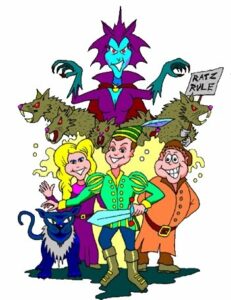
Pantomime grew out of Music Hall and by the late 19th and early 20th centuries they became the home of pantomime.
When you think of our current world of TV, DVDs and computers it is probably difficult to understand that the only popular entertainment of the time was Music Halls, which were hugely popular.
Pantomime allowed the great comedy performers of the era to thrive in the informal and unrestricted world that pantomime gave them. This led to the great male comedy actors putting on a lurid dress, a wig and some very bad make-up, which instantly got huge laughs. This was the arrival of the Dame, now a fixture in every pantomime.
s the Dame’s popularity grew, he was obviously a man dressed up as a woman, a matron-like mother, always trying to find a new husband. The fact that the Dame was a man was exaggerated, not disguised, and led to the principle boy being an attractive girl dressed up as a boy, showing lots of leg, obviously to keep the dads interested! These gender reversals made pantomime unique.
As everything in Pantomime originated from Music Hall, audience participation became inevitable, leading the phrases such as ‘Oh no it isn’t”, “Oh yes it is’ and of course ‘It’s behind you’. These catchphrases pulled the audience into the shows, and is was what made it a unique genre.
So that your children can enjoy this and get involved, our sister site Educationalmusicals.co.uk have published a series of Potty Pantos that can be performed by your children for the parents or teachers for the children.
Simply click on Potty Pantos.
Isn’t the History of Pantomome fun?
10 Questions to discuss:
- Before TV: What unique qualities did Music Halls possess that made them the dominant form of entertainment back then?
- Dames for Laughs: Why did the idea of male actors playing exaggerated “Dames” in pantomime become so popular?
- Gender Play: What was the cultural significance of the pantomime’s gender-bending roles, like the “dame” and the “principal boy”?
- Interactive Fun: How did audience participation evolve from Music Hall traditions and become integrated into pantomime?
- Iconic Phrases: What do you think makes iconic phrases like “Oh no it isn’t!” and “It’s behind you!” so effective in engaging the audience?
- Beyond Music Hall: Did any other influences contribute to the development of pantomime beyond Music Hall traditions?
- Evolution of Performance: How have the comedic elements and costumes of pantomime changed over time?
- Modern Relevance: Is the interactive nature of pantomime still important in today’s diverse entertainment landscape?
- Global Appeal: Is pantomime primarily a British tradition, or are there similar forms of audience-interactive theatre elsewhere?
- Future of Pantomime: Do you think pantomime can continue to adapt and evolve to remain relevant in future generations?
These are just some possibilities, and you can choose the ones that pique your curiosity the most!
For more on this:
http://www.its-behind-you.com/principalboy.html
© Tony Dalton

